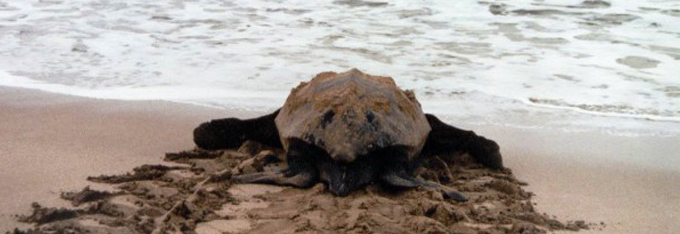The Holbrook Explorer

Sea Turtle Conservation (part 1)
Sea Turtle Conservation (part 1)
With only the moon as his guide, young conservationist and dedicated naturalist Thomas Carr and his family would trek up and down the beach of Tortuguero, Costa Rica in search of nesting sea turtles. These patrols take place every night during nesting season and are vital to the survival of the sea turtle hatchlings.
If he saw poachers, Carr would bury himself in the sand until they left.
This is one of many dangers the Carr family faced while working to protect sea turtles. It was part of his father Dr. Archie Carr’s efforts to conserve the endangered sea turtle population.
Dr. Archie Carr was one of the first scientists to draw worldwide attention to the plight of sea turtles 50 years ago.
His work led to the creation of many not-for-profit organizations dedicated to conservation and protection of sea turtles, including the Sea Turtle Conservancy in Gainesville, Fla. It was created in 1959 in honor of Carr’s award-winning book, “The Windward Road,” which first alerted the world of the suffering sea turtles. He was the scientific director of the conservancy from 1959 until his death in 1987.
His work also created a market for eco-volunteer tourism, a concept that unites travel with sustainability and conservation through education.
Eco-volunteer tourism organizations allow tourists to come to tropical regions and help conduct hands-on field research alongside local guides and scientists. Volunteers and researchers work together to reduce poaching and save hatchlings.
Human interference is the primary reason sea turtles are endangered. All six species of sea turtles are on the endangered species list. They have dealt heavily with the serious problem of poaching. Poachers kill nesting females for their meat, eggs and shells, or “carapace,” which are often used to make jewelry.
The Leatherback and Hawksbill sea turtle species are both critically endangered. Over the last 20 years, at least 90 percent or more of the population has been lost. They are facing a high risk of extinction in the wild. The Green, Black, Loggerhead and Olive Ridley species are also endangered. Despite the turtles’ endangered status, poachers continue to hunt them.
Tom Carr spent much of his life working alongside his father protecting sea turtles. He is a renowned biologist working as a sustainable tourism developer at Holbrook Travel, an educational travel provider.
Carr recalled a horrifying event in which he watched as a helpless sea turtle desperately tried to lay her eggs after having her plastron, the underside of her shell, cut out by a poacher. He used a machete to mutilate the vulnerable mother.
The female dragged her dying body along the shore, leaving a trail of entrails behind, Carr said. She was determined to lay her eggs and give her children life, something she knew she no longer had.
This is just one of many horrendous accounts that drove the Carrs to continue their fight to protect the sea turtles. It is a fight that continues today with the help of conservationists and volunteers around the world.
The Sea Turtle Conservancy is just one of the many organizations that orchestrate eco-volunteer vacations. The organization has partnered with Holbrook Travel to bring people to Tortugeruo, Costa Rica, to work with the nesting sea turtles and participate in active research opportunities.
Costa Rica’s Atlantic coast is an important nesting site for Giant Leatherback, Hawksbill, Loggerhead, and Green sea turtles. Participants work with researchers from the conservancy to monitor nesting patterns of the endangered Green sea turtle.
Read part 2 of this story.
